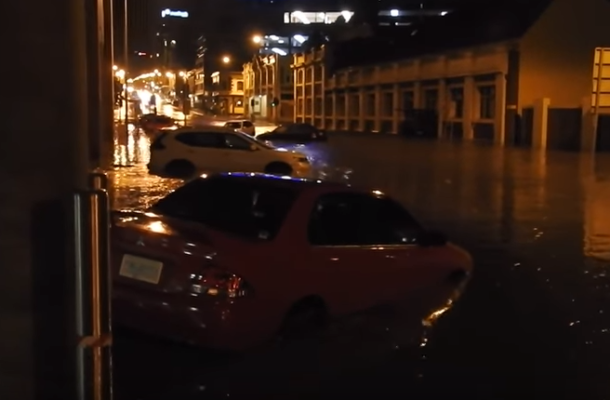A flood of questions after Hobart’s rainstorm

Record levels of rain hit Tasmania on the night of 10-11th May, causing flooding throughout the CBD. Cars were seen floating through Hobart’s central business district and homes and businesses were evacuated as flash flooding threatened to inundate them.
Hobart received 129mm of rain in the 24 hours to 9am on Friday 11th of May, the fourth highest total for any month and the highest since April 23rd in 1960. It was only the fifth time since 1893 that the city has recorded more than 10 centimetres in a day in any month and the State Emergency Service described it as “an extreme weather event”.
The flooding prompted comment from a range of experts, from the increasing likelihood of serious weather events due to ongoing climate change to the need for caution and commonsense while driving.
Climate Change
Professor Caroline Sullivan, the Professor of Environmental Economics and Policy at Southern Cross University, said “The record rainfall we have seen in Hobart over the last 36 hours is likely to be a taste of things to come. While 129mm of rain in such a short period of time would be of note anywhere, it is truly devastating when it falls over a densely populated urban area.
“Schools, hospitals, homes and businesses have been severely affected, emphasising the vulnerability that even well developed and managed locations can be exposed to. Not far away, Mount Wellington also experienced a huge rainfall event, and the cumulative effect of this on the area in general brings about the inevitable flash floods we are now seeing on an almost daily basis world-wide.
“Just last week, over a hundred people died in similar flash flooding in Kenya, with the livelihoods of thousands more severely impacted, and 260,000 people made homeless, with a risk of cholera rising.
“Figures like this serve to help us to appreciate our good fortune in being less effected that we could be in these events, but they should also serve to make us more aware of the risks we all face under a more uncertain climate of the 21st century.
“Even in Europe, in the first decade of this century, floods gave rise to some 1126 deaths, displacing about half a million people and causing at least AU$82 billion in insured economic losses (Source: EEA).
“If we want to think of what we can do to reduce our economic and social vulnerability to extreme events like this, we should be reconsidering the ways in which we use the land around us. In rural areas we should be reducing land clearing, increasing tree cover and protecting riparian zones, while in urban areas, we should be putting much more emphasis on recognising that rivers are dynamic systems, and within our urban planning frameworks we should build more Room for the River.
“Creating Room for the River is the foundation of flood planning in the European Union, under the European Flood Directive. This pan-European legislation requires flood mapping to be done on all rivers at risk, and plans to be put in place to respond to these risks to protect human health and infrastructure.
“Perhaps these Hobart floods will bring attention to these issues here in Australia, and in particular, give rise to a reconsideration of the way we manage development in all our floodplains. It is time for us to be proactive rather than reactive in the face of the extreme events now characterising our current climate regime.”
Responsible driving
Dr Richard Thornton, the CEO of the Bushfire and Natural Hazards CRC, underlined that “Significant dangers exist from floodwaters, especially flash flooding as occurred in Hobart. You do not know what dangers lurk out of sight beneath the water, and the speed and depth takes people by surprise.
“Luckily there has not been any fatalities so far from this flood in Hobart, but we know that these types of flash floods in urban settings can be incredibly dangerous – 142 people have been killed in Australia from floods like these.
It is vital that the advice of emergency services is followed, and you should never drive through floodwaters. Our research shows that across Australia floods are ranked second for total numbers of deaths from natural hazards. And it is not just the driver at risk, what about passengers, and our emergency services who risk their lives to rescue people?
“Being in a four wheel drive does not make you invincible either, with our research showing that those in four wheel drives are increasingly at risk – 75% of all fatalities involving a four wheel drive have occurred since 2000. ”
Andrew Gissing, a researcher at the Bushfire and Natural Hazards CRC and Director Government Business and Enterprise Risk Management at Risk Frontiers, agreed that “”Risk Frontiers and the Bushfire and Natural Hazards Cooperative Research Centre analysis has shown that floods are the second most deadly type of natural hazard in Australia behind heatwaves.
“Flood deaths most often occur as a result of people making a decision to enter floodwater either in a vehicle or on foot. Our research has shown that driving through floodwater is an entrenched social behaviour and that though almost everyone believes that entering floodwater is dangerous, almost everyone can identify a circumstance where they believe it is safe.
“Emergency services are right to discourage people from entering floodwater. The safety of floodwater can often be very difficult to judge, in particular the speed and depth of the water and what might be underneath. Making only a slight error of judgement can be the difference between life and death.”
Community Networks and mental health
Professor Ross Bailie, the Professor and Director of the University Centre for Rural Health at the University of Sydney, said “Our experience and research following the 2017 floods in the Northern Rivers highlighted the importance and value of community networks and volunteers, and the need for the formal emergency response and recovery organisations to engage effectively with these groups – in the immediate and longer term.
“Recent reports have shown the social costs of natural disasters to be at least as important as the costs of damage to infrastructure, and response and recovery efforts should be directed accordingly. In terms of health impacts of natural disasters in the Australian context, mental health in the form of anxiety, depression, post-traumatic stress and suicide are the big concerns.”
Professor James Bennett-Levy, the Professor of Mental Health and Psychological Wellbeing at the University of Sydney, noted that “International research, and our own research at the University Centre for Rural Health in the Northern Rivers following the 2017 floods, indicates that mental health impacts tend to be proportional to the extent that people’s homes and businesses are disrupted.
“In particular, if people are displaced from their homes for long periods, the negative mental health impacts tend to be very much worse. For businesses, insurance companies play a key role. Insurers who pay promptly and efficiently can really assist business owners to get back on their feet.
“Insurance companies that delay and haggle, or at worst use small print not to pay at all, do a big disservice to Australians already traumatised by a natural disaster.
“The lessons we have learned from the Northern Rivers in the immediate aftermath of flooding is that a rapid response from government, emergency services and insurance companies, coupled with a strong effort to get people back to their homes and communities as soon as possible, goes a long way towards mitigating the most adverse consequences of natural disasters.”

Open Forum is a policy discussion website examining the social, political, economic, cultural and environmental issues of today. We welcome contributions and invite you to follow us on Twitter, Linkedin, Federated Press and Vivaldi Social. We #StandwithUkraine.










